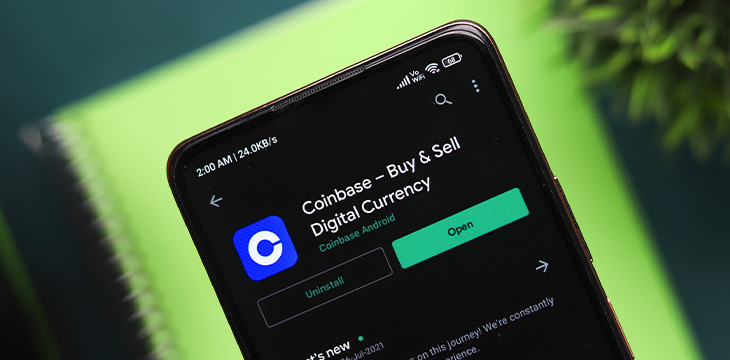|
Getting your Trinity Audio player ready...
|
Coinbase (NASDAQ: COIN) is facing liquidity rumors after the struggling cryptocurrency exchange conflated its in-house stablecoin with the U.S. dollar for online trades.
This has been a rough week for the overall digital asset market and Coinbase has in no way been spared the carnage. The exchange’s stock price briefly dipped below $45—rarely dodging a new all-time low—on Thursday before staging a minor rally to close just over $47 (-5.5%). Nonetheless, it’s a far cry from the stock’s nearly $400 peak following its direct listing on the Nasdaq in April 2021.
On Wednesday, The Intercept reported on new details of Coinbase’s controversial data-sharing deal with the U.S. Department of Homeland Security’s Immigrations and Customs Enforcement (ICE) division. The deal made headlines last September, but the terms of the $1.37 million contract remained unclear until the document was obtained by the Tech Inquiry watchdog group through a Freedom of Information Act request.
The contract reveals that ICE has a license to use Coinbase Tracer (the rebranded Coinbase Analytics) for (among other things) tracking multi-hop incoming/outgoing transactions in BTC, ETH and USDT (Tether), ‘transaction demixing and shielded transaction analysis’ and ‘historical geo tracking data.’
A Coinbase Tracer disclaimer states that it “sources its information from public sources and does not make use of Coinbase user data.” Coinbase’s official Twitter account went further on Thursday to counter the growing public alarm, stating that the exchange “does not sell proprietary customer data” and that Tracer was intended to “support compliance and help investigate financial crimes.”
The compliance caveats aren’t sitting well with Coinbase’s more libertarian customers, who appear increasingly irked by the perceived intrusions into their online activities. In 2020, Coinbase signed a four-year deal granting the U.S. Secret Service access to Coinbase Analytics. The exchange previously solicited similar arrangements with both the Internal Revenue Service (IRS) and the Drug Enforcement Administration (DEA).
Coinbase CEO Brian Armstrong said at the time that such deals were necessary to recoup the costs of developing an in-house analytics platform (although the exchange was, until this year, wildly profitable).
USDC: It’s like real money, but more fun
A potentially far more ominous development came Wednesday afternoon, when Coinbase announced that the platform will be “unifying USD and USDC order books.” The announcement added that “USDC order books will be merged under USD order books to create a better, more seamless trading experience with deeper liquidity for USD and USDC.” USDC (aka USD Coin) is the stablecoin issued by Circle, a representative from Circle clarified to CoinGeek.
The fact that Coinbase is dumping its Funbucks into the bin marked ‘actual dollars’ may indeed provide a ‘more seamless’ experience while also getting Coinbase out of a potential fiat liquidity crunch. As in, so many people have been withdrawing greenbacks during the current crypto crash that Armstrong and the rest of his C-suite may be frantically scouring the couch cushions for stray dimes as we speak.
Coinbase says exchange users “will be able to deposit USD or USDC and their account will be automatically credited on a 1:1 basis with USD. The unified USD balance can be used to trade on USD order books or withdrawn to either USD or USDC.” The deposit-specific focus of this 1:1 wording leaves open the possibility that if USDC were to lose its peg to the dollar—say, for instance, if the world discovered USDC’s reserve assets weren’t all they were claimed to be—customers might find themselves unable to withdraw dollars on a 1:1 basis.
That’s not an idle concern. USDC’s market cap has exploded over the past two years, growing from just $4 billion at the start of 2021 to nearly $56 billion today. Throughout, Circle has responded to questions regarding the reserves backing these coins with monthly ‘attestations,’ only moderately more informative than the wafer-thin quarterly reports issued by rival stablecoin Tether.
At least USDC’s attestations are provided by Grant Thornton LLP, a century-old firm and one of the largest accountancy groups in the U.S., which ordinarily would lend USDC a greater air of legitimacy. But starting this January, Grant Thornton revised the wording of its attestations from saying Circle’s reserve accounts were “correctly stated” as of the end of each month to saying they were “fairly stated.”
There’s some debate as to the significance of this alteration, as well as speculation as to why Grant Thornton chose to make this alteration when it did—if in fact it was the accountants that chose the unorthodox ‘correctly’ wording in the first place.
It also wasn’t the first time that wording around USDC’s reserves have undergone curious tweaks. Last August, Coinbase revised its USDC page from the assurance that each USDC was “backed by a U.S. dollar in a bank account” to the far less specific claim that the stablecoin was “backed by fully reserved assets.”
Coinbase/Circle’s justifications behind these linguistic gymnastics may well have some basis in reality. But it’s the type of murky uncertainty the financial community has come to associate with stablecoins, particularly given the antics of the past few months. Coinbase’s latest USDC/USD move will do nothing to alleviate these concerns. But hey, that just makes USDC more ‘fun’ than boring old dollars, right?
Like D-day, except the Germans win
Given recent events, Coinbase must feel like one of those kids’ inflatable punching bags with the clown painted on them. Goldman Sachs downgraded Coinbase to ‘sell’ on Monday, based on their view that the exchange “will need to make substantial reductions in its cost base in order to stem the resulting cash burn as retail trading activity dries up.”
Goldman’s lack of faith followed last week’s decision by Moody’s to downgrade the exchange’s credit rating, based on the agency’s view that Coinbase’s ability to post a profit would remain “challenged” for the foreseeable future. Last week also saw Coinbase rival Binance.US eliminate trading fees on BTC-stablecoin trading pairs, a step Coinbase will be pressured to match, further eroding its revenue-generating capacity.
All this followed Coinbase’s announcement that it was cutting 18% of its workforce in a bid to offset the $430 million net loss it posted in the first quarter of 2022. Coinbase has also been struggling to rebut rumors that the company is close to bankruptcy, an event that could prove catastrophic for the exchange’s retail users.
Interestingly, while trimming payroll at home, Coinbase is actively hiring in Europe, looking to the continent for growth opportunities that are eluding it stateside. Coinbase has also been trying to burnish its European image as a regulation-friendly exchange, as evidenced by the new know-your-customer (KYC) requirements it’s imposing on Dutch customers seeking to withdraw assets from the exchange.
And yet Coinbase was among the crypto firms that opposed new European Union obligations regarding KYC and anti-money laundering (AML) requirements. The new rules, provisional agreement on which was reached Wednesday, will require crypto service providers to collect more data from customers and share it with regulators upon request. The rules also require proper KYC on ‘unhosted’ private crypto wallets that engage in transactions exceeding €1,000 with wallets ‘hosted’ by the exchange. The new regime isn’t expected to take effect until 2024.
By which time, Coinbase will likely have created a super seamless trading experience by lumping in USDC with dollars, euros, yen, yuan, rupees and rubles into one great egalitarian deposit pool. (Withdrawals will only be available in Rai stones, with users responsible for shipping costs.)
Watch: BSV Global Blockchain Convention panel, The Future of Digital Asset Exchanges & Investment
https://www.youtube.com/watch?v=RzJsCRb6zt8&t=7800s
Follow CoinGeek’s Crypto Crime Cartel series, which delves into the stream of groups from BitMEX to Binance, Bitcoin.com, Blockstream, ShapeShift, Coinbase, Ripple,
Ethereum, FTX and Tether—who have co-opted the digital asset revolution and turned the industry into a minefield for naïve (and even experienced) players in the market.

 01-07-2026
01-07-2026 




